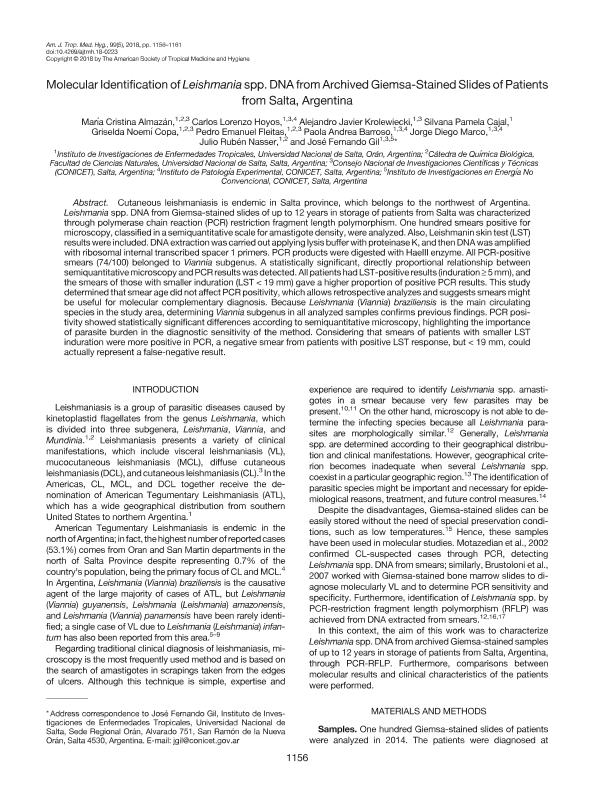Artículo
Molecular identification of Leishmania spp. DNA from archived Giemsa-Stained slides of patients from Salta, Argentina
Almazán, María Cristina ; Hoyos, Carlos Lorenzo
; Hoyos, Carlos Lorenzo ; Krolewiecki, Alejandro Javier
; Krolewiecki, Alejandro Javier ; Cajal, Silvana Pamela; Copa, Griselda Noemi
; Cajal, Silvana Pamela; Copa, Griselda Noemi ; Fleitas, Pedro Emanuel
; Fleitas, Pedro Emanuel ; Barroso, Paola Andrea
; Barroso, Paola Andrea ; Marco, Jorge Diego
; Marco, Jorge Diego ; Nasser, Julio Rubén; Gil, José Fernando
; Nasser, Julio Rubén; Gil, José Fernando
 ; Hoyos, Carlos Lorenzo
; Hoyos, Carlos Lorenzo ; Krolewiecki, Alejandro Javier
; Krolewiecki, Alejandro Javier ; Cajal, Silvana Pamela; Copa, Griselda Noemi
; Cajal, Silvana Pamela; Copa, Griselda Noemi ; Fleitas, Pedro Emanuel
; Fleitas, Pedro Emanuel ; Barroso, Paola Andrea
; Barroso, Paola Andrea ; Marco, Jorge Diego
; Marco, Jorge Diego ; Nasser, Julio Rubén; Gil, José Fernando
; Nasser, Julio Rubén; Gil, José Fernando
Fecha de publicación:
11/2018
Editorial:
American Society of Tropical Medicine and Hygiene
Revista:
American Journal of Tropical Medicine and Hygiene
ISSN:
0002-9637
Idioma:
Inglés
Tipo de recurso:
Artículo publicado
Clasificación temática:
Resumen
Cutaneous leishmaniasis is endemic in Salta province, which belongs to the northwest of Argentina. Leishmania spp. DNA from Giemsa-stained slides of up to 12 years in storage of patients from Salta was characterized through polymerase chain reaction (PCR) restriction fragment length polymorphism (RFLP). One hundred smears positive for microscopy, classified in a semiquantitative scale for amastigote density, were analyzed. Also, Leishmanin skin test (LST) results were included. DNA extraction was carried out applying lysis buffer with proteinase K, and then DNA was amplified with ribosomal internal transcribed spacer1primers. PCR products were digested with HaeIII enzyme. All PCR-positive smears (74/100) belonged to Viannia subgenus. A statistically significant, directly proportional relationship between semiquantitative microscopy and PCR results was detected. All patients had LST-positive results (induration ≥ 5 mm), and the smears of those with smaller induration (LST < 19 mm) gave a higher proportion of positive PCR results. This study determined that smear age did not affect PCR positivity, which allows retrospective analyzes and suggests smears might be useful for molecular complementary diagnosis. Because Leishmania (Viannia) braziliensis is the main circulating species in the study area, determining Viannia subgenus in all analyzed samples confirms previous findings. PCR positivity showed statistically significant differences according to semiquantitative microscopy, highlighting the importance of parasite burden in the diagnostic sensitivity of the method. Considering that smears of patients with smaller LST induration were more positive in PCR, a negative smear from patients with positive LST response, but <19mm, could actually represent a false-negative result.
Palabras clave:
LEISHMANIA
,
ARGENTINA
,
IDENTIFICATION
,
PCR
Archivos asociados
Licencia
Identificadores
Colecciones
Articulos(CCT - SALTA-JUJUY)
Articulos de CTRO.CIENTIFICO TECNOL.CONICET - SALTA-JUJUY
Articulos de CTRO.CIENTIFICO TECNOL.CONICET - SALTA-JUJUY
Articulos(IPE)
Articulos de INST.DE PATOLOGIA EXPERIMENTAL
Articulos de INST.DE PATOLOGIA EXPERIMENTAL
Citación
Almazán, María Cristina; Hoyos, Carlos Lorenzo; Krolewiecki, Alejandro Javier; Cajal, Silvana Pamela; Copa, Griselda Noemi; et al.; Molecular identification of Leishmania spp. DNA from archived Giemsa-Stained slides of patients from Salta, Argentina; American Society of Tropical Medicine and Hygiene; American Journal of Tropical Medicine and Hygiene; 99; 5; 11-2018; 1156-1161
Compartir
Altmétricas



